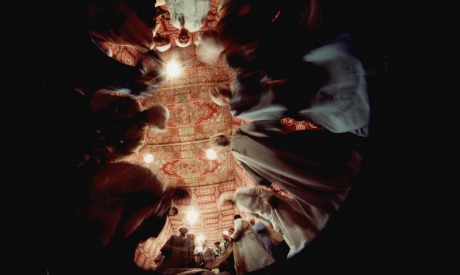
On the night of 27 Rajab, Prophet Mohammed travelled to the Aqsa Mosque on the back of a heavenly beast called the boraq. Afterwards, the prophet ascended to heaven, where he encountered angels and previous prophets and saw paradise and hell.
The boraq denotes lightening or shining (from the Arabic word Barq, lightening, or Baraqa, to shine).
This is in reference either to the light it emits or the speed at which it travels.
It is described as a winged beast and sometimes said to be the horse of Archangel Gabriel.
According to tradition, it is smaller than a mule but bigger than a donkey, with a human face, big eyes, and small ears. Its neck is said to be made of ambergris and its ears and shoulders of white pearl (or aquamarine). Its cheeks are described as resembling those of a horse.
The boraq has four legs. Its crest is said to be made of moist pearl weaved with gems and coral. Its shoulders are described as made of rubies and its eyes shine like the stars. It emits a ray of light as bright as the sun, and is very white. Its legs are said to be made of gold. Its chest, covered with gems, and shines like the stars of heaven. Its tail is studded with green emeralds, and its wings resemble those of an eagle’s. Its forelock is described as being bright as the moon and smells of incense. It breathes like a human and its udders are covered with gold.
Folk artists have painted the boraq in many styles. Images of the heavenly beast appeared in Egypt and other Arab countries first in lithograph and later in zincograph. Images produced on glass appeared in Tunisia and Syria.
According to al-Domeiri, the whiteness of the boraq is a reference to its high status.
The chronicler Ibn Hesham said the boraq was winged. Sources differ on whether Archangel Gabriel rode on the boraq with the prophet or not. There is also a discrepancy on whether the boraq was first ridden by Prophet Mohammad or used by other prophets, including Ibrahim (or Abraham), in the past.
In the oral tradition we see variations on the boraq theme. The horse of Seif Bin Ze Yazan, for instance, is called Barq al-Buruq (or supreme lightening). It can fly over mountains and valleys carrying the folk hero to battle the worshippers of fire.
The Israa and Miaraj is considered a major religious event during which some Muslims fast during the day and then engage in religious rituals and Koran reading. Usually, a banquet of meat (zafar, or flesh) is prepared for this special night.
In the Sharqia governorate, the event is celebrated on the night of 27 Rajab, following the Isha (evening) prayers.
Worshippers gather in a mosque and a sheikh recites verses from the Koran, especially those mentioning the Israa and Miaraj miracle.
The sheikh then recounts the story of the Israa and Miaraj to the audience (the Koran mentions the story in a brief manner, but it is elaborated upon in non-Koranic tradition).
Gifts are usually exchanged on this occasion. Parents send meat, fowl, fruit and vegetables to married children in a gesture of silat rahem, or kinship, says a resident of the Gita village in Sharqia.
The popular celebration of the Israa and Miaraj takes another form in Minya.
The celebrations there last for three days, 25-27 Rajab. The celebration begins daily after the maghreb (sunset) prayers at the mausoleum and mosque of al-Fuli.
First, Sheikh Ahmad al-Fuli recites from the Koran, then religious songs are performed by celebrity singers, including Sheikh Abdel Badie, Sheikha Samah and Sheikha Kawthar.
In Cairo, the evening’s celebrations are often combined with the Sayyeda Zeinab moulid (birthday) celebrations, and invariably draw in large crowds
No comments:
Post a Comment